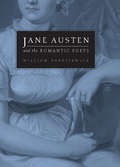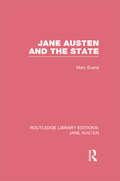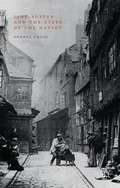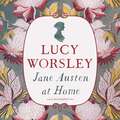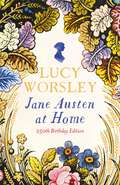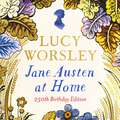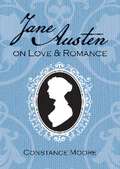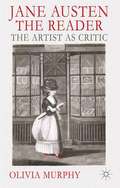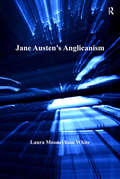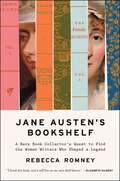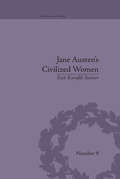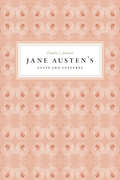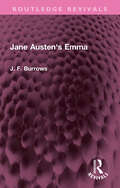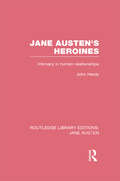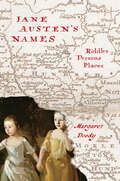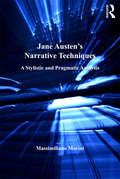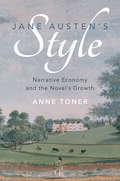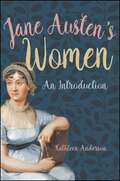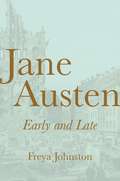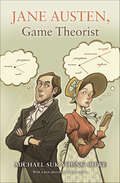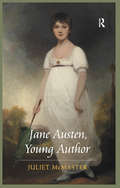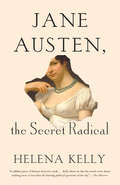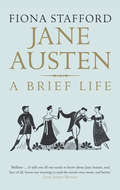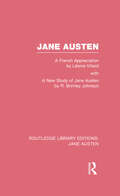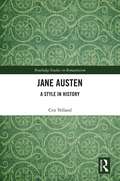- Table View
- List View
Jane Austen and the Romantic Poets
by William DeresiewiczThis elegant and thoughtful work offers an important new way of understanding Jane Austen by defining the fundamental impact and influence of British Romanticism on her later novels. In comparing the earlier and later phases of Austen's career, Deresiewicz addresses an important yet neglected issue regarding her work: the longstanding critical consensus that Austen's last three novels (Mansfield Park, Emma, and Persuasion) represent far greater artistic achievements than do her first three (Northanger Abbey, Sense and Sensibility, and Pride and Prejudice). Jane Austen and the Romantic Poets offers a rich account of the differences between the two phases of Austen's career. In doing so, it contextualizes her later novels within the British Romantic movement and the works of Wordsworth, Coleridge, Scott, and Byron. Through close readings of Mansfield Park, Emma, and Persuasion, Deresiewicz reveals the importance of Romantic ideas in Austen's later work, considering the ways in which the novels investigate hidden mechanisms of psychic and affective life, including "substitution," "ambiguous relationships," and "widowhood." Deresiewicz's innovative approach and its emphasis on Romanticism opens up new perspectives on Austen's later novels by exploring their patterns of imagery, narrative logics, and social and historical dimensions.
Jane Austen and the State (Routledge Library Editions: Jane Austen)
by Mary EvansJane Austen is often associated with conservatism and her novels are often seen as light entertainment depicting a vanished world and its manners. Mary Evan's study, first published in 1987, seeks to contradict the conventional wisdom regarding Austen's social and political leanings and argues that far from endorsing established and conservative views Jane Austen advances a radical critique of the morality of bourgeois capitalism and demonstrates a concern for the articulation of women's rights and views whilst simultaneously drawing attention to the vulnerability of women in the economic marketplace. Mary Evans adopts a multidisciplinary approach and her book will appeal to anyone who is interested in Jane Austen's writing as well as those concerned with the moral basis of contemporary politics.
Jane Austen and the State of the Nation
by Sheryl CraigJane Austen and the State of the Nation explores Jane Austen's references to politics and to political economics and concludes that Austen was a liberal Tory who remained consistent in her political agenda throughout her career as a novelist. Read with this historical background, Austen's books emerge as state-of-the-nation or political novels.
Jane Austen at Home: A Biography
by Lucy Worsley'This is my kind of history: carefully researched but so vivid that you are convinced Lucy Worsley was actually there at the party - or the parsonage.' Antonia Fraser'A refreshingly unique perspective on Austen and her work and a beautifully nuanced exploration of gender, creativity, and domesticity.' Amanda ForemanOn the 200th anniversary of Jane Austen's death, historian Lucy Worsley leads us into the world in which our best-loved novelist lived. This new telling of the story of Jane's life shows us how and why she lived as she did, examining the rooms, spaces and possessions which mattered to her, and the way in which home is used in her novels to mean both a place of pleasure and a prison. It wasn't all country houses and ballrooms, in fact her life was often a painful struggle.Jane famously lived a 'life without incident', but with new research and insights Lucy Worsley reveals a passionate woman who fought for her freedom. A woman who far from being a lonely spinster in fact had at least five marriage prospects, but who in the end refused to settle for anything less than Mr Darcy.(P)2017 Hodder & Stoughton Limited
Jane Austen at Home: A Biography
by Lucy WorsleyTHE SUNDAY TIMES BESTSELLER'This is my kind of history: carefully researched but so vivid that you are convinced Lucy Worsley was actually there at the party - or the parsonage.' Antonia Fraser'A refreshingly unique perspective on Austen and her work and a beautifully nuanced exploration of gender, creativity, and domesticity.' Amanda ForemanLucy Worsley 'is a great scene-setter for this tale of triumph and heartbreak.' Sunday TimesOn the 200th anniversary of Jane Austen's death, historian Lucy Worsley leads us into the rooms from which our best-loved novelist quietly changed the world.This new telling of the story of Jane's life shows us how and why she lived as she did, examining the places and spaces that mattered to her. It wasn't all country houses and ballrooms, but a life that was often a painful struggle. Jane famously lived a 'life without incident', but with new research and insights Lucy Worsley reveals a passionate woman who fought for her freedom. A woman who far from being a lonely spinster in fact had at least five marriage prospects, but who in the end refused to settle for anything less than Mr Darcy.
Jane Austen at Home: A Biography (250th Birthday Edition)
by Lucy WorsleyTo celebrate the 250th anniversary of Jane Austen's birth, Lucy Worsley has written a new Introduction to her Sunday Times Bestselling biography - the book that leads us into the rooms from which our best-loved novelist quietly changed the world.This telling of the story of Jane's life shows us how and why she lived as she did, examining the places and spaces that mattered to her. It wasn't all country houses and ballrooms, but a life that was often a painful struggle. Jane famously lived a 'life without incident', but with new research and insights Lucy Worsley reveals a passionate woman who fought for her freedom. A woman who far from being a lonely spinster in fact had at least five marriage prospects, but who in the end refused to settle for anything less than Mr Darcy.
Jane Austen on Love and Romance
by Constance Moore'There are certainly not so many men of large fortune in the world, as there are pretty women to deserve them' If you want to make like Elizabeth Bennet and live happily ever after with a man who owns half of Derbyshire, then arm yourself with this Austen-tatious guide to flirting and courtship.
Jane Austen the Reader
by Olivia MurphyHow did Jane Austen come to write six novels that are still widely regarded as some of the highest achievements of the genre? The answer lies in understanding what Austen read, and how she read it. Jane Austen the Reader shows how the books Austen read - and the critical way in which she read them - influenced her writing, and her artistic innovations. Austen's steadfast belief in the possibilities of fiction sustained her through early rejection and disappointment, and led to the creation of some of literature's masterpieces. Austen devoured drama, history, poetry and novels, but it was not just as a passive consumer looking for entertainment, nor as a writer searching for ideas that Austen engaged with literature. Rather, she was a critical reader - investigating and evaluating literature, and articulating in her own works her vision of what the novel could be.
Jane Austen's Anglicanism: Theory, Practice, And Product
by Laura Mooneyham WhiteIn her re-examination of Jane Austen's Anglicanism, Laura Mooneyham White suggests that engaging with Austen's world in all its strangeness and remoteness reveals the novelist's intensely different presumptions about the cosmos and human nature. While Austen's readers often project postmodern and secular perspectives onto an Austen who reflects their own times and values, White argues that viewing Austen's Anglicanism through the lens of primary sources of the period, including the complex history of the Georgian church to which Austen was intimately connected all her life, provides a context for understanding the central conflict between Austen's malicious wit and her family's testimony to her Christian piety and kindness. White draws connections between Austen's experiences with the clergy, liturgy, doctrine, and religious readings and their fictional parallels in the novels; shows how orthodox Anglican concepts such as natural law and the Great Chain of Being resonate in Austen's work; and explores Austen's awareness of the moral problems of authorship relative to God as Creator. She concludes by surveying the ontological and moral gulf between the worldview of Emma and Oscar Wilde's The Importance of Being Earnest, arguing that the evangelical earnestness of Austen's day had become a figure of mockery by the late nineteenth century.
Jane Austen's Bookshelf: A Rare Book Collector's Quest to Find the Women Writers Who Shaped a Legend
by Rebecca RomneyFrom rare book dealer and guest star of the hit show Pawn Stars, a page-turning literary adventure that introduces readers to the women writers who inspired Jane Austen—and investigates why their books have disappeared from our shelves.Long before she was a rare book dealer, Rebecca Romney was a devoted reader of Jane Austen. She loved that Austen&’s books took the lives of women seriously, explored relationships with wit and confidence, and always, allowed for the possibility of a happy ending. She read and reread them, often wishing Austen wrote just one more. But Austen wasn&’t a lone genius. She wrote at a time of great experimentation for women writers—and clues about those women, and the exceptional books they wrote, are sprinkled like breadcrumbs throughout Austen&’s work. Every character in Northanger Abbey who isn&’t a boor sings the praises of Ann Radcliffe. The play that causes such a stir in Mansfield Park is a real one by the playwright Elizabeth Inchbald. In fact, the phrase &“pride and prejudice&” came from Frances Burney&’s second novel Cecilia. The women that populated Jane Austen&’s bookshelf profoundly influenced her work; Austen looked up to them, passionately discussed their books with her friends, and used an appreciation of their books as a litmus test for whether someone had good taste. So where had these women gone? Why hadn&’t Romney—despite her training—ever read them? Or, in some cases, even heard of them? And why were they no longer embraced as part of the wider literary canon? Jane Austen&’s Bookshelf investigates the disappearance of Austen&’s heroes—women writers who were erased from the Western canon—to reveal who they were, what they meant to Austen, and how they were forgotten. Each chapter profiles a different writer including Frances Burney, Ann Radcliffe, Charlotte Lennox, Charlotte Smith, Hannah More, Elizabeth Inchbald, Hester Lynch Thrale Piozzi, and Maria Edgeworth—and recounts Romney&’s experience reading them, finding rare copies of their works, and drawing on connections between their words and Austen&’s. Romney collects the once-famed works of these forgotten writers, physically recreating Austen&’s bookshelf and making a convincing case for why these books should be placed back on the to-be-read pile of all book lovers today. Jane Austen&’s Bookshelf will encourage you to look beyond assigned reading lists, question who decides what belongs there, and build your very own collection of favorite novels.
Jane Austen's Civilized Women: Morality, Gender and the Civilizing Process (Gender and Genre #9)
by Enit Karafili SteinerJane Austen’s six complete novels and her juvenilia are examined in the context of civil society and gender. Steiner’s study uses a variety of contexts to appraise Austen’s work: Scottish Enlightenment theories of societal development, early-Romantic discourses on gender roles, modern sociological theories on the civilizing process.
Jane Austen's Cults and Cultures
by Claudia L. JohnsonJane Austen completed only six novels, but enduring passion for the author and her works has driven fans to read these books repeatedly, in book clubs or solo, while also inspiring countless film adaptations, sequels, and even spoofs involving zombies and sea monsters. Austen's lasting appeal to both popular and elite audiences has lifted her to legendary status. In Jane Austen's Cults and Cultures, Claudia L. Johnson shows how Jane Austen became "Jane Austen," a figure intensely--sometimes even wildly--venerated, and often for markedly different reasons. Johnson begins by exploring the most important monuments and portraits of Austen, considering how these artifacts point to an author who is invisible and yet whose image is inseparable from the characters and fictional worlds she created. She then passes through the four critical phases of Austen's reception--the Victorian era, the First and Second World Wars, and the establishment of the Austen House and Museum in 1949--and ponders what the adoration of Austen has meant to readers over the past two centuries. For her fans, the very concept of "Jane Austen" encapsulates powerful ideas and feelings about history, class, manners, intimacy, language, and the everyday. By respecting the intelligence of past commentary about Austen, Johnson shows, we are able to revisit her work and unearth fresh insights and new critical possibilities. An insightful look at how and why readers have cherished one of our most beloved authors, Jane Austen's Cults and Cultures will be a valuable addition to the library of any fan of the divine Jane.
Jane Austen's Emma (Routledge Revivals)
by J. F. BurrowsFirst published in 1968, Jane Austen’s Emma is a critical study of Miss Austen’s last completed novel. While often pausing to analyse and comment on major contemporary critics, Dr. Burrows provides a detailed insight into this outstanding novel. He has clarified certain of the book’s qualities, placing detail back into its proper context and perspective. Comic relief is contrasted with the serious and the sensitivity and capacity for change of her chief personages and the subtle use of such of Austen’s words as ‘sensible’ and ‘amiable’ are deftly treated. A select bibliography is included. This book will be of interest to students of literature, women’s studies, gender studies as well as to casual readers of Jane Austen’s novels.
Jane Austen's Heroines: Intimacy in Human Relationships (Routledge Library Editions: Jane Austen)
by John Philips HardyFirst published in 1984, John Hardy's important interpretation of Jane Austen's heroines breaks through the accepted tradition of viewing the author as merely a rational comedienne of manners. He argues instead that Jane Austen's greatness lies in her exploration of human relationships through the subtle and original portrayal of her heroines. Jane Austen's heroines come to enjoy a distinctive relationship with the men they eventually marry. Between her lovers the potential exists for the kind of intimacy that leads to a shared privacy. Austen's recognition of this represents her special insight into what is of central importance in human relationships. Her belief that love and friendship are our only hope of triumphing over solitude, and the character and integrity of her heroines, are the major elements which make Jane Austen's novels so satisfying.
Jane Austen's Names: Riddles, Persons, Places
by Margaret DoodyIn Jane Austen’s works, a name is never just a name. In fact, the names Austen gives her characters and places are as rich in subtle meaning as her prose itself. Wiltshire, for example, the home county of Catherine Morland in Northanger Abbey, is a clue that this heroine is not as stupid as she seems: according to legend, cunning Wiltshire residents caught hiding contraband in a pond capitalized on a reputation for ignorance by claiming they were digging up a "big cheese”--the moon’s reflection on the water’s surface. It worked. In Jane Austen’s Names, Margaret Doody offers a fascinating and comprehensive study of all the names of people and places--real and imaginary--in Austen’s fiction. Austen’s creative choice of names reveals not only her virtuosic talent for riddles and puns. Her names also pick up deep stories from English history, especially the various civil wars, and the blood-tinged differences that played out in the reign of Henry VIII, a period to which she often returns. Considering the major novels alongside unfinished works and juvenilia, Doody shows how Austen’s names signal class tensions as well as regional, ethnic, and religious differences. We gain a new understanding of Austen’s technique of creative anachronism, which plays with and against her skillfully deployed realism--in her books, the conflicts of the past swirl into the tensions of the present, transporting readers beyond the Regency. Full of insight and surprises for even the most devoted Janeite, Jane Austen’s Names will revolutionize how we read Austen’s fiction.
Jane Austen's Narrative Techniques: A Stylistic and Pragmatic Analysis
by Massimiliano MoriniCombining linguistic theory with analytical concepts and literary interpretation and appreciation, Jane Austen's Narrative Techniques traces the creation and development of Austen's narrative techniques. Massimiliano Morini employs the tools developed by post-war linguistics and above all pragmatics, the study of the ways in which speakers communicate meaning, since Austen's 'wordings' can only be interpreted within the fictional context of character-character, narrator-character, narrator-reader interaction. Examining a wide range of Austen texts, from her unpublished works through masterpieces like Mansfield Park and Emma, Morini discusses familiar Austen themes, using linguistic means to shed fresh light on the question of point of view in Austen and on Austen's much-admired brilliance in creating lively and plausible dialogue. Accessibly written and informed by the latest work in linguistic and literary studies, Jane Austen's Narrative Techniques offers Austen specialists a new avenue for understanding her narrative techniques and serves as a case study for scholars and students of pragmatics and applied linguistics.
Jane Austen's Style: Narrative Economy and the Novel's Growth
by Anne TonerJane Austen is renowned for the economy of her art: for the close focus of her romantic plots and the precision of her writing style. Exploring that economy stylistically and structurally, this book traces Austen's keen interest in narrative form. Anne Toner pinpoints techniques that are fundamental to the distinctiveness of Austen's fiction, many of which have been little explored to date. Toner argues that Austen's conciseness in terms of plotting, narrative description and in the depiction of dialogue also contributed to her innovations in representing thought, expanding the novel's capacity to depict consciousness. Narrative and rhetorical features are presented clearly and accessibly and will open up new ways of thinking about prose style with implications for the study of fiction beyond Austen's own.
Jane Austen's Women: An Introduction
by Kathleen AndersonWhy does Jane Austen "mania" continue unabated in a postmodern world? How does the brilliant Regency novelist speak so personally to today's women that they view her as their best friend? Jane Austen's Women answers these questions by exploring Austen's affirming yet challenging vision of both who her dynamic female characters are, and who they become. This important new work analyzes the heroines' relationships to body, mind, spirit, environment, and society. It reveals how, despite a restrictive patriarchal culture, these women achieve greatness. In clear, lively prose, Kathleen Anderson shares original theoretical insights from twenty years of studying Austen, and illuminates the novels as guidebooks on how to become an Austenian heroine in one's everyday life. This engaging book will appeal to a broad readership: the serious student, the general lit-lover, and the Austen neophyte alike.
Jane Austen, Early and Late
by Freya JohnstonA reexamination of Austen’s unpublished writings that uncovers their continuity with her celebrated novels—and that challenges distinctions between her “early” and “late” workJane Austen’s six novels, published toward the end of her short life, represent a body of work that is as brilliant as it is compact. Her earlier writings have routinely been dismissed as mere juvenilia, or stepping stones to mature proficiency and greatness. Austen’s first biographer described them as “childish effusions.” Was he right to do so? Can the novels be definitively separated from the unpublished works? In Jane Austen, Early and Late, Freya Johnston argues that they cannot.Examining the three manuscript volumes in which Austen collected her earliest writings, Johnston finds that Austen’s regard and affection for them are revealed by her continuing to revisit and revise them throughout her adult life. The teenage works share the milieu and the humour of the novels, while revealing more clearly the sources and influences upon which Austen drew. Johnston upends the conventional narrative, according to which Austen discarded the satire and fantasy of her first writings in favour of the irony and realism of the novels. By demonstrating a stylistic and thematic continuity across the full range of Austen’s work, Johnston asks whether it makes sense to speak of an early and a late Austen at all.Jane Austen, Early and Late offers a new picture of the author in all her complexity and ambiguity, and shows us that it is not necessarily true that early work yields to later, better things.
Jane Austen, Game Theorist: Updated Edition
by Michael Suk-Young ChweHow the works of Jane Austen show that game theory is present in all human behaviorGame theory—the study of how people make choices while interacting with others—is one of the most popular technical approaches in social science today. But as Michael Chwe reveals in his insightful new book, Jane Austen explored game theory's core ideas in her six novels roughly two hundred years ago—over a century before its mathematical development during the Cold War. Jane Austen, Game Theorist shows how this beloved writer theorized choice and preferences, prized strategic thinking, and analyzed why superiors are often strategically clueless about inferiors. Exploring a diverse range of literature and folktales, this book illustrates the wide relevance of game theory and how, fundamentally, we are all strategic thinkers.
Jane Austen, Young Author
by Juliet McMasterIn her lively and accessibly written book, Juliet McMaster examines Jane Austen’s acute and frequently uproarious juvenile works as important in their own right and for the ways they look forward to her novels. Exploring the early works both collectively and individually, McMaster shows how young Austen’s fictional world, peopled by guzzlers and unashamed self-seekers, operates by an ethic of energy rather than the sympathy that dominates the novels. A fully self-conscious artist, young Jane experimented freely with literary modes - the epistolary, the omniscient, the drama. Early on, she developed brilliantly pointed dialogue to match her characters. Literary parody impels her creativity, and McMaster’s sustained study of Love and Friendship shows the same intricate relation of the parody to the work it parodies that we later see with Northanger Abbey and the Gothic novel. As an illustrator herself, McMaster is especially attuned to the explicit and sometimes hilarious descriptions of bodies that preceded Austen’s famous reticence about physicality. Rather than focusing on the immaturities of the juvenilia, McMaster maps the gradual shifts in tone and emphasis that signpost Austen’s journey as a writer. She shows, for instance, how the shameless husband-hunting in The Three Sisters and the vigorous partisanship of The History of England lead on to Pride and Prejudice. Her book will appeal to Austen’s critics and to passionate general readers, as well as to scholars working in the fields of juvenilia, children’s literature, and childhood studies.
Jane Austen, the Secret Radical
by Helena KellyA brilliant, illuminating reassessment of the life and work of Jane Austen that makes clear how Austen has been misread for the past two centuries and that shows us how she intended her books to be read, revealing, as well, how subversive and daring--how truly radical--a writer she was. In this fascinating, revelatory work, Helena Kelly--dazzling Jane Austen authority--looks past the grand houses, the pretty young women, past the demure drawing room dramas and witty commentary on the narrow social worlds of her time that became the hallmark of Austen's work to bring to light the serious, ambitious, deeply subversive nature of this beloved writer. Kelly illuminates the radical subjects--slavery, poverty, feminism, the Church, evolution, among them--considered treasonous at the time, that Austen deftly explored in the six novels that have come to embody an age. The author reveals just how in the novels we find the real Jane Austen: a clever, clear-sighted woman "of information," fully aware of what was going on in the world and sure about what she thought of it. We see a writer who understood that the novel--until then seen as mindless "trash"--could be a great art form and who, perhaps more than any other writer up to that time, imbued it with its particular greatness.
Jane Austen: A Brief Life
by Fiona StaffordEvery devoted reader feels that, in some way, they know Jane Austen. But how can we make sense of her extraordinary achievements? At a time when most women received so little formal education and none could obtain a place at university, how did Austen come to write novels that have commanded the attention of some of the most brilliant minds ever since? Why were hers the books that Darwin knew by heart and Churchill read during the Blitz? In this graceful introduction to the author’s life and works, Fiona Stafford offers a fresh and accessible perspective, discussing Austen’s six astonishing novels in the context of their time. Newly updated, Jane Austen: A Brief Life offers a rich and sympathetic insight into a writer who was just as much the Romantic genius as Keats, Shelley or Byron – full of youthful exuberance, intensely creative once she had found her individual voice, and dead before she reached middle age.
Jane Austen: A French Appreciation (Routledge Library Editions: Jane Austen)
by Léonie Villard R. Brimley JohnsonFirst published in 1924, this unique title provides an extremely valuable early Twentieth Century perspective on Jane Austen, offering analysis from both sides of the channel. The book includes both a translated study of Jane Austen by French academic Léonie Villard, and a study by influential biographer and critic, R. Brimley Johnson. Johnson's study, made with particular reference to the unpublished epistolary novel, Love and Friendship, seeks to redress the balance of contemporary criticism of Austen, challenging the established links between Austen and Nineteenth Century realism, and suggesting instead that her work owes a great deal to the conventions of romance. He also demonstrates how her art transformed from the parody of Nothanger Abbey to the portraiture of the later novels. Léonie Villard's ambitious work analyses a variety of topics relating to Austen's work, including women and marriage, psychology, satire, the gentry and the lasting value and scope of the novels. All in all, a very engaging, informative and insightful reissue.
Jane Austen: A Style in History (Routledge Studies in Romanticism)
by Cris YellandFrom 1809 until just before her death, Jane Austen lived in a small, all-female household at Chawton, where reading aloud was the evening's entertainment and a crucial factor in the way Austen formed and modified her writing. This book looks in detail at Jane Austen's style. It discusses her characteristic abstract vocabulary, her adaptations of Johnsonian syntax and how she came to make her most important contribution to the technique of fiction, free indirect discourse. The book draws extensively on historical sources, especially the work of writers like Johnson, Hugh Blair and Thomas Sheridan, and analyses how Austen negotiated her path between the fundamentally masculine concerns of eighteenth-century prescriptivists and her own situation of a female writer reading her work aloud to a female audience.
